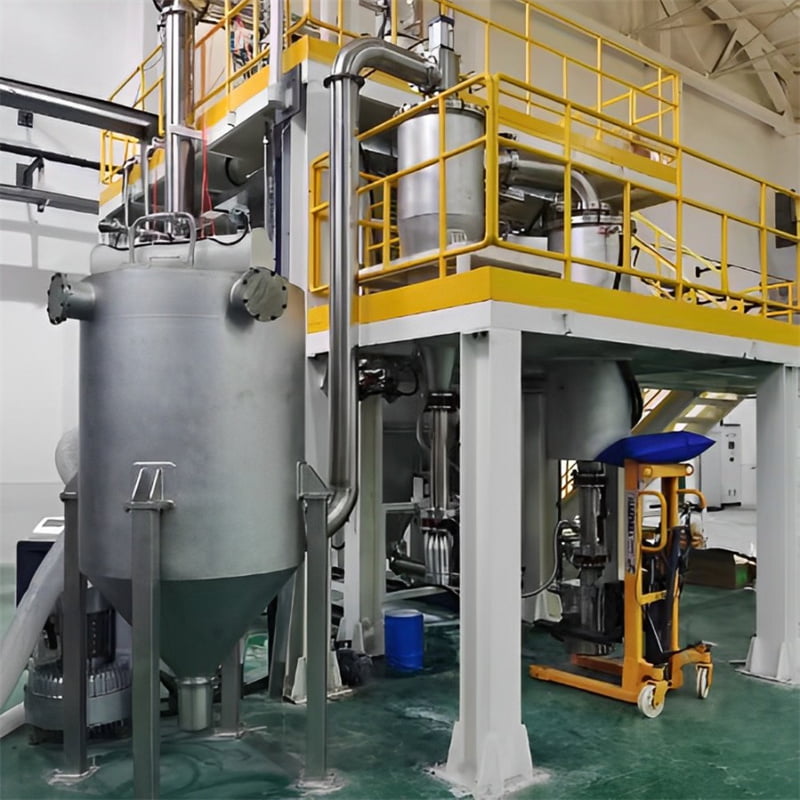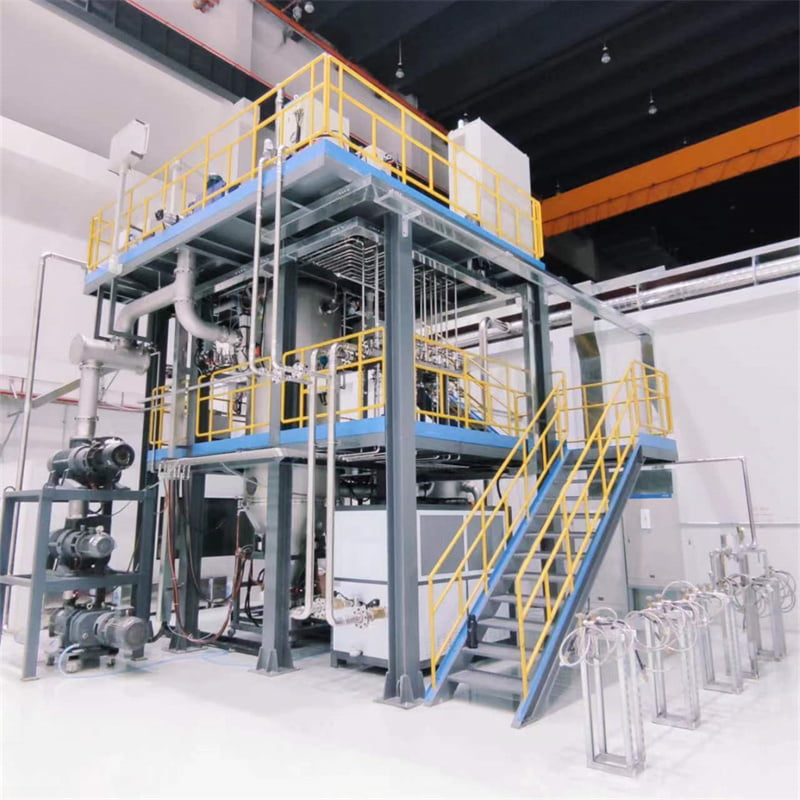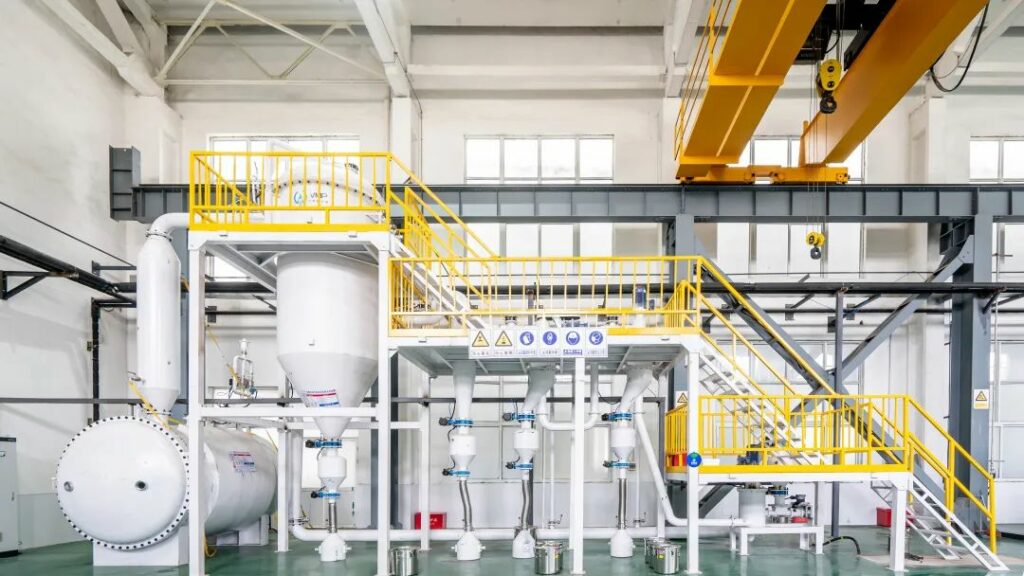Översikt över metallförstoftningsteknik
Innehållsförteckning
Metallförstoftning är en specialiserad teknik som används för att producera fina metallpulver med exakta partikelstorlekar och egenskaper. Denna avancerade process har revolutionerat metalltillverkningen inom olika industrier som förlitar sig på högkvalitativa metallpulver som råmaterial.
Denna omfattande guide kommer att ge en djupdykning i alla aspekter av metallförstoftningsteknik. Vi kommer att täcka hur det fungerar, dess tillämpningar, typer av finfördelningssystem, produktegenskaper, kostnadsanalys, leverantörer, standarder och mer. Oavsett om du vill använda den här tekniken eller bara vill lära dig mer om den, har den här guiden alla detaljer som krävs.
Översikt över metallförstoftningsteknik
Metallförstoftning är en metod för att förvandla metall till pulver genom att bryta upp smält metall till små droppar som stelnar till pulverpartiklar. Det innefattar följande huvudsteg:
Smältande: Råmetallmaterialet smälts med en induktionsugn eller en elektrisk ljusbågsugn. Vanliga metaller finfördelade inkluderar aluminium, koppar, järn, nickel, titan, kobolt, etc.
Atomisering: Den smälta metallströmmen bryts till fina droppar genom att utsätta den för höghastighetsstrålar av vatten, luft eller inert gas. Olika finfördelningsmedier och krafter används för att kontrollera partikelstorlek och form.
Solidifiering: Dropparna stelnar snabbt till pulverpartiklar när de svalnar. Nedkylningshastigheten påverkar mikrostrukturen. Snabbare kylning ger finare korn.
Samling: De finfördelade pulverpartiklarna samlas upp för siktning, siktning, glödgning, beläggning och andra sekundära processer före användning.
Det färdiga metallpulvret har en exakt kontrollerad partikelstorleksfördelning som vanligtvis sträcker sig från 10 till 250 mikron. Pulvrets morfologi, sammansättning och mikrostruktur är anpassad för att möta applikationskrav.
Några av de stora fördelarna med metallatomiseringsteknik inkluderar:
- Extremt fin och konsekvent kontroll av pulverpartikelstorlek
- Förmåga att finfördela reaktiva och högsmältande legeringar
- Pulver med anpassad legeringskemi och mikrostrukturer
- Kostnadseffektiv produktion av metallpulver i stora kvantiteter
- Hög renhet av pulver och lägre kontaminering
Metallförstoftning möjliggör tillverkning av högpresterande delar från avancerade metallpulver som annars är svåra produkter med konventionell gjutning, smide eller mekanisk legering.
Låt oss titta på de olika typerna av atomiseringssystem, pulveregenskaper, tillämpningar och andra aspekter av denna teknik.

Typer av system för metallförstoftning
Det finns flera tekniker som används för finfördelning av metaller till pulver. Finfördelningsmetoden och systemet väljs baserat på materialet, önskade pulveregenskaper, produktionshastighet och kostnadsöverväganden.
| Finfördelningstyp | Mekanism | Partikelstorlek | Vanliga metaller |
|---|---|---|---|
| Atomisering av vatten | Högtrycksvattenstråle bryter upp smält metallström | 50 – 250 μm | Järnlegeringar som rostfritt stål, verktygsstål, låglegerat stål |
| Atomisering av gas | Inertgasstrålar som används för finfördelning | 10 - 150 μm | Nickel, kobolt, titanlegeringar; reaktiva och högsmältande metaller |
| Process med roterande elektrod | Centrifugalkrafter sönderdelar smält metall på snurrande kopp/skiva | 5 - 150 μm | Koppar, aluminium, magnesium, tenn, bly |
| Plasmaatomisering | Plasmabåge smälter och finfördelar metaller till ultrafina pulver | 5 – 50 μm | Speciallegeringar, reaktiva metaller som titan, zirkonium etc. |
Atomisering av vatten
Vid vattenförstoftning sönderdelas den smälta metallströmmen som kommer ut ur ugnen av strålar av höghastighetsvatten som kommer från flera munstycken som omger den. Vattenstrålarna bryter upp metallen till fina droppar. Vattnet släcker och kyler snabbt dropparna till fast pulver.
Detta är den mest använda atomiseringstekniken med tanke på dess lägre utrustningskostnad. Den kan producera pulver i storleken 50-250 mikron från legeringar med relativt låg smältpunkt som stål, zink, tenn etc. Men vattenfördelning kanske inte fungerar bra för reaktiva metaller som titan som kan reagera med vatten och syre.
Atomisering av gas

Gasatomisering använder strålar av inert gas som kväve, argon eller helium för att förvandla den flytande metallen till en spray av droppar under kontrollerade förhållanden. Eftersom inget vatten eller syre kommer i kontakt med metallen minimeras oxidationen vilket möjliggör produktion av reaktiva metallpulver.
Gasstrålarna ger också finare kontroll över partikelstorlek ner till 10-150 mikron. Gasatomiserade pulver har en sfärisk morfologi som föredras vid formsprutning av metall. Men utrustningen är mer sofistikerad och driftskostnaderna är högre än vattenförstoftning.
Process med roterande elektrod

I denna metod strömmar den smälta metallströmmen ut på periferin av en roterande elektrodskiva eller kopp. Centrifugalkrafter kastar bort fina droppar från metallen som sedan stelnar till pulver.
Roterande elektrodförstoftning är idealisk för icke-järnhaltiga metaller med lägre smältpunkt som aluminium, magnesium, zink, tenn, koppar etc. Den genererar metallpulver i storleksintervallet 25-150 mikron.
Plasmaatomisering
Plasmaatomisering använder extremt höga temperaturer av plasmabåge (10 000-15 000°C) för att smälta och finfördela reaktiva och eldfasta metaller. Den höga värmen från plasma smälter snabbt och sprider metaller med smältpunkter över 2500°C till fina pulver.
Plasmasystem kan producera mycket sfäriska pulver ner till 5-50 mikron storlek. Men det kräver mycket specialiserad utrustning och är en dyr process som endast lämpar sig för nischapplikationer.
Egenskaper hos finfördelade metallpulver
De olika egenskaperna hos finfördelade metallpulver som partikelstorlek, form, kemi, mikrostruktur, densitet etc. avgör deras lämplighet för den avsedda användningen. Genom att kontrollera atomiseringsprocessens parametrar kan pulver anpassas till exakta specifikationer.
Partikelstorlek och -form
- Partikelstorleksfördelning är en kritisk egenskap som påverkar kompaktering, sintring, prestanda.
- Vatten- och gasatomisering ger fina pulver från 10 till 250 mikron storlek. Plasma kan gå ner till 5 mikron.
- Partikelformen är beroende av finfördelningstekniken. Gas och plasma producerar mycket sfäriska partiklar som föredrages i metallformsprutningsråvara.
| Parameter | Roll och effekt |
|---|---|
| Partikelstorlek | Påverkar flöde, packningsdensitet, krympning, sintring, mikrostruktur, styrka, ytfinish |
| Partikelform | Sfärisk form förbättrar flytbarheten och komprimeringen; oregelbundna former förbättrar den mekaniska låsningen |
Kemisk sammansättning
- Kemisk analys av metallpulver görs för att säkerställa att sammansättningen ligger inom specificerade gränser för legeringen.
- Förlust av flyktiga grundämnen som Zn, Mg under finfördelning måste redovisas genom startladdningsjusteringar.
- Mindre variationer i sammansättningen kan drastiskt förändra de mekaniska egenskaperna genom förstärkning av fast lösning, utfällning etc.
| Legeringssammansättningskontroll | Betydelse |
|---|---|
| Kol, syre, kvävenivåer | Påverka mikrostruktur och mekaniska egenskaper |
| Legeringselement | Upprätthåll specificerad kemi för önskade egenskaper |
| Föroreningsnivåer | Påverkar defekter och kvalitet |
Faser och mikrostruktur
- Snabb stelning under finfördelning leder till fina mikrostrukturer med raffinerade korn, utökad fast löslighet, metastabila faser etc.
- Värmebehandling och glödgning kan användas för att modifiera faser och mikrostruktur enligt applikationsbehov.
| Parameter | Roll |
|---|---|
| Faser närvarande | Påverkar styrka, hårdhet, duktilitet, seghet, elektriska egenskaper mm. |
| Kornstorlek | Finare korn förbättrar draghållfasthet och hårdhet genom Hall-Petch-effekten |
| Porositet/densitet | Högre densitet ökar styrkan; porositet sänker utmattningsmotståndet |
Ytkemi
- Ytkemin hos pulver påverkar deras flöde, packningsdensitet, sintrings- och packningsbeteende under komponenttillverkning.
- Glödgning och torrbeläggning ger kontrollerade ytoxidskikt för att optimera pulveregenskaperna.
| Aspekt | Syfte |
|---|---|
| Ytoxider | Förbättrar flödet; för mycket oxid kan försämra packning och sintring |
| Smörjmedelsbeläggningar | Hjälper till pulverflöde och packning; påverkar tätheten |
| Passiveringslager | Minska reaktiviteten och känsligheten hos reaktiva pulver |
Genom att optimera dessa pulveregenskaper kan finfördelning producera pulver av hög kvalitet som är skräddarsydda för att möta behoven hos avancerad tillverkningsteknik.
Tillämpningar av metallatomiseringsteknik
Finfördelade metallpulver finner utbredd användning inom tillverkning inom flyg-, fordons-, medicin-, elektronik-, försvars- och andra industrier. Några av huvudapplikationerna är:
Pulvermetallurgi
- Pressa och sintra komponenter
- Råmaterial för formsprutning av metall (MIM)
- Additiv tillverkningspulver för 3D-utskrift
Gjutning och svetsning
- Pulverförstoftning för gravitation och precisionsgjutning
- Pulver för lödning, svetsningsvaror
Beläggningar och termisk spray
- Termiska spraypulver för slitage/korrosionsbeständiga beläggningar
- Pulverlackering för dekorativa och skyddande ytbehandlingar
Pulverkomprimering
- P/M-komprimerade produkter som växlar, lager och bussningar
- Högdensitetsdelar genom kall/varm isostatisk pressning
Magneter och elektronik
- Sintrade sällsynta jordartsmetaller permanentmagneter
- Mjuka magnetiska komponenter som induktorer, sensorer
- Ledande metallpulver för pastor, EMI-skärmning
Kemiska och strukturella förpackningar
- Porösa metallfilter från sintrade pulverstrukturer
- Metallskummaterial med stor yta
Finfördelade pulver möjliggör tillverkning av högpresterande komponenter med egenskaper överlägsna traditionella tillverkningsvägar. Genom att använda förlegerade pulver kan delar tillverkas av mycket hårda metaller som verktygsstål, koboltkrom och nickellegeringar.
Kritiska applikationer inom flyg-, medicin- och bilindustrin förlitar sig i stor utsträckning på precisionskomponenter tillverkade av finfördelade pulver på grund av deras exemplariska mekaniska egenskaper och tillförlitlighet.
Låt oss gå igenom några specifika exempel som visar kapaciteten hos teknik för atomisering av metallpulver.
Fallexempel 1: Ortopediska implantat av titanlegering
- Biokompatibel titanlegering TI-6AL-4V pulver produceras med användning av finfördelning av inert gas förhindrar oxidation.
- Exakt partikelstorleksfördelning säkerställer utmärkt flöde och packningstäthet för metallformsprutning.
- Kontrollerad legeringskemi resulterar i helt biokompatibla implantat med hög styrka.
- Fin mikrostruktur från snabb stelning förbättrar utmattningsprestandan.
- Komplext formade implantat kan tillverkas kostnadseffektivt.
Fallexempel 2: Turbindelar av nickelsuperlegering
- Inert gas atomiserade förlegerade nickel superlegeringspulver för additiv tillverkning.
- Förmåga att finfördela högtemperaturbeständiga superlegeringar inte möjlig med gjutning.
- Finkornig struktur med jämn fördelning av stärkande partiklar.
- Komponenter uppvisar utmärkta mekaniska egenskaper vid hög temperatur.
- Intrikata kylkanaler och design möjliga genom 3D-utskrift.
Fallexempel 3: Mjuka magnetiska ferritdelar
- Vattenförstoftat järnpulver med kontrollerat lågt syreinnehåll.
- Optimerad pulverform och storleksfördelning för packning.
- Pressad och sintrad till mycket magnetiskt permeabla komponenter som induktorer.
- Utmärkta magnetiska egenskaper uppnås genom exakt kemikontroll.
- Kostnadsfördelar jämfört med ferritmagneter bearbetade av bulklegeringar.
Dessa exempel illustrerar den avgörande roll som metallförstoftningstekniken spelar för att möjliggöra högpresterande avancerad tillverkning inom flera industrier.
Kostnadsanalys av metallatomisering
Här är en titt på några av kostnadsfaktorerna som är involverade i metallförstoftningsprocessen:
- Kapitalutrustning: Specialiserade smältugnar, atomiseringskärl, pulveruppsamlingssystem representerar stora fasta kostnader. Ytterligare utrustning som behövs för sekundär bearbetning som siktning, beläggning, värmebehandling.
- Rörelsekostnader: Förbrukningsvaror som vatten, gas, el är återkommande kostnader. Underhåll och personal ökar driftskostnaderna.
- Råvaror: Metallinsatser av metallurgisk kvalitet för smältning och legeringsberedning är en variabel kostnad beroende på materialtyp och kvalitet.
- Avkastning: Pulveråtervinningsutbytet från finfördelningsprocessen påverkar användbar produktion. Avkastningsförluster ska minimeras genom processoptimering.
- Produktionskapacitet: Installerad kapacitet baserat på ugnsstorlek, atomiseringsmunstycken etc. bestämmer maximal pulverproduktion per timme och slag per enhetskostnad.
- Kvalitetskontroll: Testning och karakterisering för att säkerställa att pulvret uppfyller specifikationerna ökar också produktionskostnaderna.
- Stordriftsfördelar: Större produktionsvolymer förbättrar kostnadseffektiviteten på grund av bättre utnyttjande av investeringar i fasta kapital.
Den valda atomiseringstekniken påverkar också ekonomin:
| Atomiseringsmetod | Kostnad för utrustning | Förbrukningsmaterial Kostnad | Output Rate |
|---|---|---|---|
| Atomisering av vatten | Lägre | Lägre | Medium |
| Atomisering av gas | Hög | Hög | Långsam |
| Plasmaatomisering | Mycket hög | Mycket hög | Låg |
För de flesta kostnadskänsliga tillämpningar ger vattenförstoftning det bästa värdet. Men för mer avancerade legeringar och pulver kan gas- och plasmatekniker vara nödvändiga trots högre kostnader.
Det typiska kostnadsintervallet för finfördelade metallpulver baserat på volym och pulverkvalitet:
| Parameter | Kostnadsintervall |
|---|---|
| Nickellegeringspulver (gas atomiserat) | $50 - $120 per kg |
| Titanlegeringspulver (Plasmaatomiserat) | $270 – $450 per kg |
| Pulver av rostfritt stål (vattenförstoftat) | $5 – $30 per kg |
| Järnbaspulver (vattenatomiserat) | $2 – $7 per kg |
Trots kostnaderna skapar atomisering enormt värde genom att möjliggöra avancerad komponenttillverkning inom flyg-, medicin-, fordons- och andra avancerade teknologisektorer.
Standarder och specifikationer
För att säkerställa kvalitet och konsistens hos finfördelade metallpulver har olika standarder publicerats av standardiseringsorganisationer:
ASTM International
- ASTM B215: Standard för gasatomisering av aluminiumpulver
- ASTM B964: Standard för gasatomisering av titanlegeringspulver
- ASTM B819: Standard för nominell skenbar densitet för metalliska pulver och kompakter
- ASTM B833: Standardspecifikation för titanlegeringspulver för beläggningar och turboladdarkompressorhjul
ISO-standarder
- ISO 4490: Metallpulver – Bestämning av syrehalt genom reduktionsmetoder
- ISO 5832-4: Implantat för kirurgi — Metalliska material — Del 4: Kobolt-krom-molybden gjutlegering
Andra standarder
- SAE AMS 7002: Värmebehandling av titanlegeringspulver
- MPIF Standard 35: Materialstandarder för formsprutade metalldelar
- AMS 7016: Metalliska pulver som används för bearbetning av pulvermetallurgi (P/M)
Dessa standarder hjälper till att definiera materialkemi, partikelegenskaper, provtagningsmetoder, testprocedurer, kvalitetsacceptansnivåer och andra parametrar förknippade med metallpulver som produceras genom finfördelningsprocess.
Att följa tillämpliga standarder är avgörande i industrier som flyg och medicin där material- och prestandaspecifikationer är noggrant kontrollerade. Standarderna ger också ett gemensamt tekniskt språk mellan pulverproducenter och industriella användare.
Att välja en leverantör av metallpulveratomisering
Att välja rätt leverantör är nyckeln till att få högkvalitativa metallpulver som är skräddarsydda för dina specifika komponentproduktionsbehov. Här är några faktorer att utvärdera:
Teknisk förmåga
- Erfarenhet och expertis med den speciella legerings- och finfördelningsprocessen
- Rätt utrustning och anläggningar som passar materialet och kapaciteten
- Strikt kvalitetssäkring och testförmåga
- Kompetent teknisk support för anpassning och optimering
Prestandarekord
- Beprövad meritlista av att leverera till stora OEM-tillverkare eller pulvermetallurgitillverkare
- Prover utvärderade för att validera påstådda pulveregenskaper
- Bevis på kundnöjdhet och lojal långsiktig kundkrets
Anpassningsförmåga
- Flexibilitet för att skräddarsy pulveregenskaper som partikelstorlek, form, kemi etc.
- Öppenhet för samutvecklingsprojekt för att producera konstruerade pulver
- Olika atomiseringstekniker och sekundär bearbetning tillgängliga
Affärssäkerhet
- Etablerat företag med solid ekonomi och stabil leveranskapacitet
- Lyhördhet för behov inklusive snabba leveranser och support efter försäljning
- Konkurrenskraftig och transparent prisstruktur
- Starka relationer med råvaruleverantörer
Att utvärdera leverantörer på både tekniska och kommersiella kriterier säkerställer bättre att du får pulver som konsekvent uppfyller dina tillverknings- och kvalitetskrav till ett rimligt pris.
Fördelar och begränsningar med metallpulveratomisering
Fördelar
- Konsekvent partikelstorleksfördelning ner till 10 mikron
- Kostnadseffektiv produktion av kundanpassade legeringar
- Pulver med hög renhet med minimal kontaminering
- Fin mikrostruktur från snabb stelning
- Produkter med överlägsna mekaniska egenskaper
- Miljömässigt renare process jämfört med gjutning
- Förenklar tillverkning av komplexa, högpresterande komponenter
- Utökar utbudet av tillverkarbara legeringar utöver konventionell smältning
Begränsningar
- Hög kapitalinvestering krävs för utrustning
- Begränsad produktionskapacitet per finfördelningsenhet
- Ytterligare nedströmsbearbetning krävs för att uppnå slutliga pulveregenskaper
- Form- och morfologibegränsningar vid vattenförstoftning
- Reaktiva material kräver kontrollerad inert finfördelning
- Stabilitets- och hanteringskrav för fina pulver
- Kostnadsfaktorer begränsar för närvarande ansökningar
Trots vissa begränsningar är metallförstoftning en oumbärlig teknik som möjliggör produktion av skräddarsydda pulver som erbjuder avsevärda förbättringar i materialprestanda och komponenttillverkningsförmåga.

Vanliga frågor
Vilket är det typiska partikelstorleksintervallet som uppnås vid gasatomisering?
Gasatomisering kan ge mycket fina och exakta metallpulver, vanligtvis i intervallet 10 till 150 mikron. Justering av gastrycket och munstycksdesignen tillåter storlekskontroll från 10-45 mikron för ultrafina pulverkrav.
Hur fungerar vattenförstoftning?
Vid vattenförstoftning sönderdelas den smälta metallströmmen av höghastighetsvattenstrålar till små droppar som snabbt stelnar till pulverpartiklar. Vattenstrålarna bryter upp metallen och ger även snabb kylning.
Vilka metaller kan finfördelas till pulver?
Nästan alla kommersiella metaller och legeringar inklusive rostfritt stål, verktygsstål, titanlegeringar, nickel superlegeringar, aluminiumlegeringar, koppar och kopparlegeringar kan finfördelas till pulver. Även mycket reaktiva metaller som titan, zirkonium, niob kan finfördelas med användning av inertgas eller plasmatekniker.
Vad är det typiska utbytet från finfördelningsprocessen?
Pulveråtervinningsutbytet är typiskt 80-95% för vatten- och gasatomisering. En del metall går förlorad som överdimensionerade partiklar som inte uppfyller storleksspecifikationerna. Finare kontroll av finfördelningsparametrar kan öka utbyten. Plasmaatomisering ger lägre utbyten på 50-75% på grund av mycket höga temperaturer.
Dela på
MET3DP Technology Co, LTD är en ledande leverantör av lösningar för additiv tillverkning med huvudkontor i Qingdao, Kina. Vårt företag är specialiserat på 3D-utskriftsutrustning och högpresterande metallpulver för industriella tillämpningar.
Förfrågan för att få bästa pris och anpassad lösning för ditt företag!
Relaterade artiklar

Högpresterande segment för munstycksvingar: Revolutionerande turbineffektivitet med 3D-utskrift i metall
Läs mer "Om Met3DP
Senaste uppdateringen
Vår produkt
KONTAKTA OSS
Har du några frågor? Skicka oss meddelande nu! Vi kommer att betjäna din begäran med ett helt team efter att ha fått ditt meddelande.

Metallpulver för 3D-printing och additiv tillverkning
FÖRETAG
PRODUKT
cONTACT INFO
- Qingdao City, Shandong, Kina
- [email protected]
- [email protected]
- +86 19116340731
















